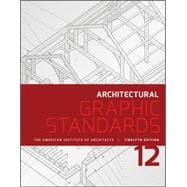The 'Architect's Bible' since 1932, updated with the latest codes and standards
Architectural Graphic Standards is the written authority for architects, designers, and building contractors. It provides comprehensive guidance on the visual representation of materials, products, systems, and assemblies. Updated to reflect the most current codes and standards, this new 12th edition features over 300 new drawings, tables, and designs and twenty-five percent new content. In response to architects' feedback and overwhelming demand for a more graphics-heavy format, this edition employs shorter, more accessible texts and more images of the standards and evolution of design and construction. New coverage includes building resiliency and the building envelope, expert discussion on the fundamentals of design and construction documentation, and new examination of environmental factors and material properties and performance. Sustainable Design is no longer separated, but incorporated throughout, and extensive appendices keep useful data right at your fingertips.
Graphic standards are essential to building design. They cover everything from door frames and roof designs to air ducts and outdoor sports facilities. This meticulous resource provides a compendium of planning standards, optimum dimensions, and normative construction details. The book is organized into three core sections covering: design and documentation, materials, and building elements.
Architectural Graphic Standards features:
- Key architectural design and production processes—functional planning, environmental assessment, building resiliency, and architectural construction documentation
- Thorough coverage of materials: concrete, masonry, metals, wood, plastics, composites, and glass
- An exhaustive survey of building elements—substructures, shells, services, equipment, furnishings, special structures, and siteworks
- Comprehensive appendixes filled with pertinent data such as: classic architectural elements, mathematical data, and structural calculations
Endorsed by the American Institute of Architects, this book has an enduring and unsurpassed reputation for high-quality illustration, text, and graphic design. For crucial information in a user-friendly format, Architectural Graphic Standards is the go-to reference on building design and construction.








